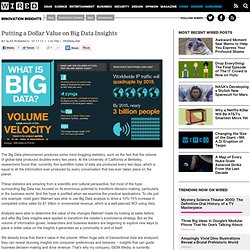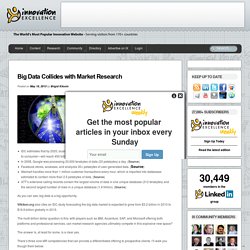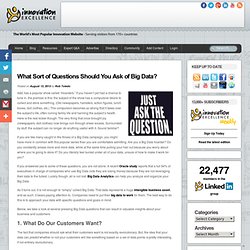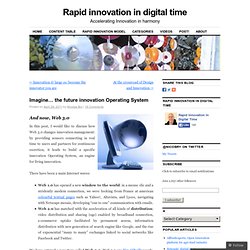

Putting a Dollar Value on Big Data Insights. Image: BBVAtech/Flickr The Big Data phenomenon produces some mind-boggling statistics, such as the fact that the volume of global data produced doubles every two years.

At the University of California at Berkeley, researchers found that, currently, five quintillion bytes of data are produced every two days, which is equal to all the information ever produced by every conversation that has ever taken place on the planet. These statistics are amazing from a scientific and cultural perspective, but most of the hype surrounding Big Data has focused on its enormous potential to transform decision-making, particularly in the business world.
And the hype is justified when we examine the practical applications. To cite just one example, retail giant Walmart was able to use Big Data analysis to drive a 10%-15% increase in completed online sales for $1 billion in incremental revenue, which is a well-planned ROI using data. Big Data Collides with Market Research. The Top 3 Reasons Market Research Agencies Can Thrive in the Era of Big Data Lately I have found it impossible to scan my numerous RSS feeds without the term “Big Data” staring me in the face on nearly every page.

And there’s good reason for that: Big Data is big business. And it’s growing all the time. To add some scale to big data’s explosion, consider these statistics from wikibon.org: IDC estimates that by 2020, business transactions on the Internet—both business-to-business and business-to-consumer—will reach 450 billion per day. As you can see, big data is a big opportunity. Wikibon.org also cites an IDC study forecasting the big data market is expected to grow from $3.2 billion in 2010 to $16.9 billion globally in 2015. The multi-billion dollar question is this: with players such as IBM, Accenture, SAP, and Microsoft offering both platforms and professional services, can market research agencies ultimately compete in this explosive new space? Sound familiar? Wait! What Sort of Questions Should You Ask of Big Data? A&E has a popular show called “Hoarders.”

If you haven’t yet had a chance to tune in, the premise is this: the subject of the show has a compulsive desire to collect and store something. (Old newspapers, hamsters, action figures, lunch boxes, doll clothes, etc.) This compulsion becomes so strong that it takes over the subject’s life, often ruining family life and harming the subject’s health. Here is the real kicker though: The very thing that once brought joy (newspapers, doll clothes) now brings ruin through sheer excess. Surrounded by stuff, the subject can no longer do anything useful with it. If you are like many caught in the throes of a Big Data campaign, you might have more in common with this popular series than you are comfortable admitting: Are you a Big Data hoarder? As it turns out, it is not enough to “simply” collect Big Data. Below, we take a look at several pressing Big Data questions that can result in valuable insights about your business and customers: 1. 2. 3. 4. The art of Big Data innovation.
Big data: The next frontier for innovation, competition, and productivity. The amount of data in our world has been exploding, and analyzing large data sets—so-called big data—will become a key basis of competition, underpinning new waves of productivity growth, innovation, and consumer surplus, according to research by MGI and McKinsey's Business Technology Office.

Leaders in every sector will have to grapple with the implications of big data, not just a few data-oriented managers. The increasing volume and detail of information captured by enterprises, the rise of multimedia, social media, and the Internet of Things will fuel exponential growth in data for the foreseeable future. Imagine… the future innovation Operating System. And now, Web 3.0 In this post, I would like to discuss how Web 3.0 changes innovation management: by providing sensors connecting in real time to users and partners for continuous cocretion, it leads to build a specific innovation Operating System, an engine for living innovation.

There have been 2 main Internet waves: Web 1.0 has opened a new window to the world: in a mouse clic and a stridently modem connection, we were looking from France at american colourful textual pages such as Yahoo! , Altavista, and Lycos, navigating with Netscape mosaic, developing “one to one” communication with emails.Web 2.0 has matched with the acceleration of all kinds of distribution: video distribution and sharing (ugc) enabled by broadband connection, e-commerce uptake facilitated by permanent access, information distribution with new generation of search engine like Google, and the rise of exponential “many to many” exchanges linked to social networks like Facebook and Twitter.